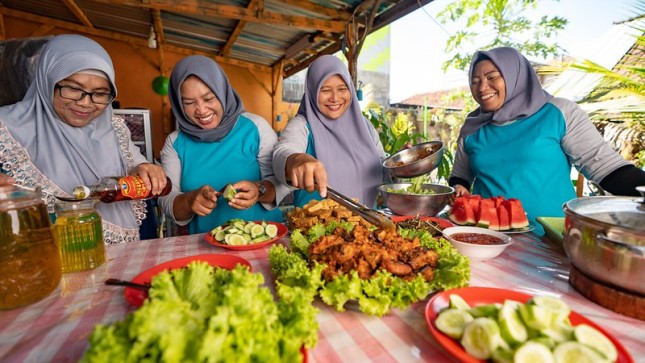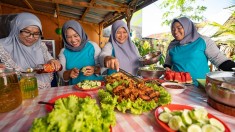-
Connecting the Dots: Women’s Economic Empowerment and Reproductive Health
October 11, 2023 By Vina Smith-Ramakrishnan
In the fight for global gender equality, women’s economic empowerment and sexual and reproductive health and rights (SRHR) are intrinsically linked. This year, for instance, the Biden-Harris administration launched the U.S. Strategy on Global Women’s Economic Security. The interagency strategy is the first of its kind, and it lays out a vision in which women and girls around the world, in all their diversity, are able to fully, meaningfully, and equally contribute to, and benefit from, economic growth and global prosperity.

In the fight for global gender equality, women’s economic empowerment and sexual and reproductive health and rights (SRHR) are intrinsically linked.
This year, for instance, the Biden-Harris administration launched the U.S. Strategy on Global Women’s Economic Security. The interagency strategy is the first of its kind, and it lays out a vision in which women and girls around the world, in all their diversity, are able to fully, meaningfully, and equally contribute to, and benefit from, economic growth and global prosperity. What’s more, the new strategy specifically highlights that fact that “an important contributor to women’s meaningful economic participation is a woman’s ability to determine whether, when, and how to have a family.”
The objectives that must be achieved are clear. Goal 5 of the 2030 Sustainable Development Goals, “achieve gender equality and empower all women and girls”, includes targets to ensure women’s full and effective participation and equal opportunities for leadership at all levels of the economy, and to recognize and value unpaid and domestic labor.
Yet women’s economic empowerment currently lags behind global targets, despite domestic and international commitments to the goal of gender equality. Fortunately, there are actions that can be taken to advance SRHR and, consequently, improve women’s economic empowerment and gender equality.
Women’s Economic Power
Having access to economic power increases women’s access to resources and opportunities that include property, financial services, skills development, and market information. Empowering women in the economy and closing the gender pay gap are key steps to achieving the 2030 Agenda for Sustainable Development. They are also central to realizing women’s rights and gender equality, which carries with it significant potential to further the global economy. Research shows that women’s economic equality boosts economic growth and leads to better development outcomes.
What’s clear is that women are working. Globally, women spend roughly twice as much time on average than men on household work—and five times as much on childcare. Unfortunately, they often go unpaid for this informal and domestic labor. And when women do enter the formal workforce, their work is not being valued at the same level as men working in comparable roles.
As it stands, the United Nations has estimated that it would take an additional 140 years in order for women to be represented equally in positions of power and leadership in the workplace. Forty-five percent of countries have yet to mandate equal remuneration for work of equal value. And, despite making up 40 percent of total employment globally, women hold only 28 percent of management positions.
A Crossroads Between Production and Reproduction
The Development Alternatives with Women for a New Era (DAWN) network’s platform, written for the Fourth World Conference on Women in Beijing in 1995, acknowledged that women stand at the crossroads between production and reproduction. This still rings true today. The global ripple effects of continuing attacks on sexual and reproductive health and rights in the U.S. are one bit of evidence for this. The World Economic Forum’s 2022 Global Gender Gap Report— showing that no country has yet achieved full gender parity—offers more support for this conclusion.
A woman’s reproductive years (15-49) and her years of working age tend to share a sizable overlap, so pregnancy and childbearing naturally have significant impacts on economic outcomes and labor force participation. Improving access to sexual and reproductive health services, including contraception, family planning, and abortion care, is directly linked to higher labor force participation for women. This is especially true in the Global South, where the unmet need for modern contraception is a crisis.
A global gender pay gap is not the only hurdle for women. There is also what is known as a “motherhood wage penalty”, which actually makes up 80 percent of that gender pay gap. When women are unable to have autonomy over their bodies—and dictate if, when, and how they choose to become parents—their power over their economic situation and the economic situation of their families and households also diminishes.
Achieving True Gender Equality
Achieving true gender equality cannot occur without women’s economic empowerment. And the inextricable links between women’s economic empowerment and SRHR mean that we cannot accomplish one objective without embracing the other.
Women and girls everywhere deserve their full human rights—including reproductive rights. Yet they remain a right in name only for many of the world’s women. Such rights are empty and meaningless if there is a lack of access and affordability to exercise them. The ability to fulfill SRHR needs should not be d upon your socioeconomic status, your insurance status, or the country you live in.
The U.S. Strategy on Global Women’s Economic Security is a great launching pad for connecting the dots between women’s economic empowerment and SRHR, but advocates and policymakers must continue encouraging further progress. Investing meaningfully in SRHR programs globally is necessary to achieve a world that is healthy, economically thriving, and equitable.
Vina Smith-Ramakrishnan is a senior policy associate at The Century Foundation, where she works on issues related to maternal health and reproductive rights and justice.
Sources: DAWN; ICRW; IMF; OECD; Population Institute; Sex and Reproductive Health Matters; United Nations; U.S. Department of State; U.S. Supreme Court; World Economic Forum.
Photo Credit: Karya Wiguna Gunda women’s group in Candirenggo village, East Java, Indonesia. UN Women/Satu Bumi Jaya.
 A Publication of the Stimson Center.
A Publication of the Stimson Center.




